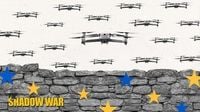As tensions simmer across Europe’s eastern flank, the continent is facing a new and rapidly evolving threat: the proliferation of drones in its skies. On October 1, 2025, the Ukrainian military began deploying a mission in Denmark, aiming to share its hard-won expertise in drone defense with European allies. This move, announced by Ukrainian President Volodymyr Zelenskyy, comes at a time when European defense ministers are racing to construct a so-called "drone wall"—a network designed to detect, track, and intercept drones that violate European airspace along the borders with Russia and Ukraine.
“Our military has begun deploying a mission in Denmark to disseminate Ukrainian experience in drone defense,” Zelenskyy stated, as reported by the Associated Press. The urgency is palpable: Denmark has recently reported drone sightings at both military facilities and airports, and Danish intelligence officials have warned that the risk of Russian espionage and sabotage in Denmark remains high, though they have stopped short of directly naming Russia as the culprit.
Poland, too, has turned to Ukraine for guidance, after more than a dozen drones—reportedly launched from Russia—breached Polish airspace in early September, with some being shot down by military aircraft and others crashing after running out of fuel. In Denmark, one incident was so disruptive that Copenhagen Airport was temporarily closed, highlighting the potential for civilian chaos as well as military risk.
European readiness and technology, however, are lagging far behind those of Ukraine and Russia, both of which have spent the past three years locked in a brutal, drone-intensive war since Moscow’s full-scale invasion of Ukraine. According to Zelenskyy, “Ukrainian (drone) experience is the most relevant in Europe right now, and it is our experience, our specialists, and our technologies that could become a key element of the future European ‘drone wall’—a large-scale project that will guarantee safety in the sky.”
The European Commission’s proposal for a "drone wall" brings together ten member states—Bulgaria, Denmark, Estonia, Hungary, Latvia, Lithuania, Poland, Romania, Slovakia, and Finland—along with Ukraine. NATO has also joined the conversation, recognizing that the alliance currently lags behind both Russia and Ukraine when it comes to drone warfare. Alexandr Burilkov, assistant director for research at the GLOBSEC GeoTech Centre, told Euronews, “NATO is still less capable on drones compared to both Ukraine and Russia. The Russians have the advantage of a large industry, while the Ukrainians have their Brave-1 innovation ecosystem, which is more flexible than Russia’s. But both are ahead of Europe.”
The rapid evolution of drone technology is both a blessing and a curse for European defense planners. Drones can be iterated and upgraded much faster than traditional military hardware—often being 3D printed with commercial electronics—making mass production feasible. “If you want to upgrade a tank, a warship, or a plane, this can be a big effort that takes years. A drone is often 3D printed and uses commercial electronics or engines, so it's very simple to start iterating on better versions,” Burilkov explained. However, Europe currently lacks the production capacity to match the scale of drone use seen in Ukraine, where both sides have deployed millions of small quadcopters and thousands of larger, long-range drones.
Burilkov emphasized the need for Europe to set up flexible capacities: “It makes more sense to have a dual track where you build up production capability so you can scale production if you need to, but you also stay at the leading edge of innovation when it comes to drones.” He cautioned against stockpiling current models, which may quickly become outdated, and stressed the importance of integrating drone capabilities with traditional military assets like tanks, artillery, and aircraft. “Otherwise, you end up with a military force that maybe has sufficient drone capability, but is also very fragile because it doesn't have all these traditional capabilities like tanks that are working as part of combined, mechanised warfare.”
The challenge doesn’t end with technology. Differing national protocols across EU member states pose significant obstacles to a unified "drone wall." In Germany, for example, military training is frequently disrupted by drones, but neutralizing them—especially in populated areas—can be fraught with risk. “If it happens in a populated area, like with these airport intrusions in Denmark, you can't even start shooting it without risking harm,” Burilkov noted. Developing a unified policy and cross-border cooperation for drone neutralization is proving to be a complex task.
Political dynamics further complicate matters. The European Commission was initially hesitant to include Slovakia and Hungary—both of which have close ties to Russia—in the drone wall initiative. However, after Slovakia joined, Hungary also received an invitation. Despite Budapest’s multi-vector foreign policy, Hungary’s military is largely equipped with European hardware, and the country hosts significant defense manufacturing facilities. “Whereas the foreign policy of Budapest might not always be in tune with the rest of the European Union, from the perspective of contributing to European security, the Hungarians contribute to a high level,” Burilkov observed.
Meanwhile, the human toll of drone warfare remains devastatingly clear. On the night of October 1, a Russian drone strike killed a family of four—a young married couple and their two sons, aged four and six—in Ukraine’s northeastern Sumy region. “This is a terrible and irreparable loss for the entire community and the region,” wrote regional administration head Oleh Hryhorov. In Dnipro, another Russian drone attack killed one person and injured at least 20 more. President Zelenskyy responded by stressing, “All of us in Europe must build a reliable defense against Russian drones and missiles—so that no country stands alone against this threat.”
Yet not everyone is convinced by Europe’s current approach. Kremlin spokesman Dmitry Peskov criticized the "drone wall" plan, stating, “History shows that building walls is always bad. We are continuing to see such militarist approach instead of thinking how to engage in a dialogue and jointly search for security guarantees.”
While some experts, like Burilkov, caution against overreacting—pointing out that similar incidents occurred routinely during the Cold War without leading to direct conflict—there is a growing consensus that Europe must be pragmatic, prepared, and innovative in the face of a rapidly changing threat. As NATO steps up aerial surveillance in the Baltic Sea and France, Germany, and Sweden bolster Denmark’s air defenses ahead of key summits in Copenhagen, the continent finds itself at a crossroads: learning from the past, but urgently preparing for a future where the battle for the skies is fought not just with jets and missiles, but with swarms of drones and the expertise of those who have already faced them on the front lines.
In the end, Europe’s ability to adapt—technologically, politically, and militarily—may determine whether its skies remain safe, or whether the shadow of drone warfare continues to grow.




